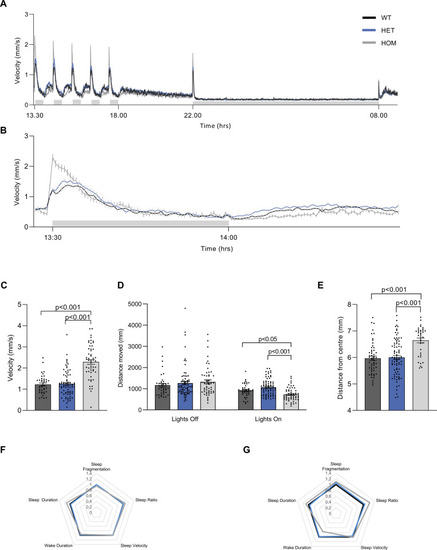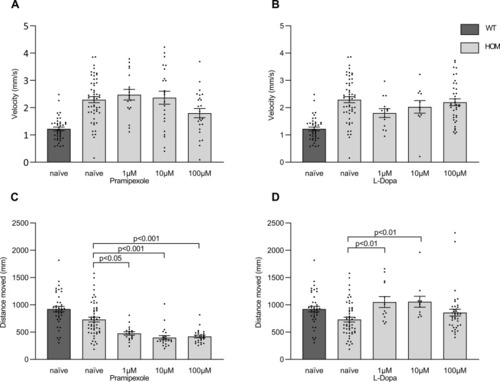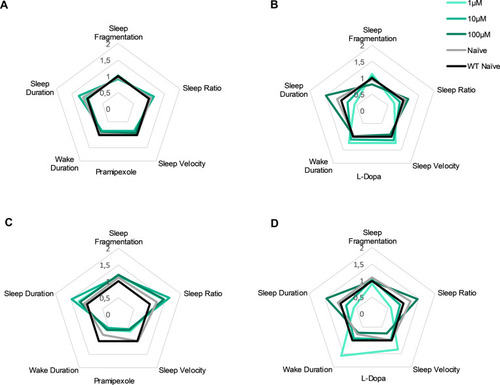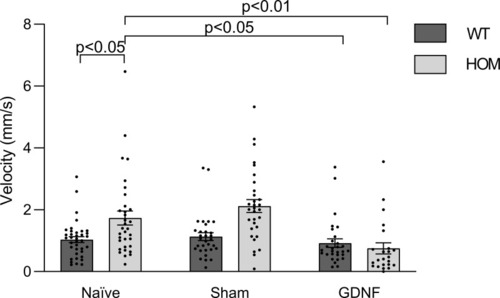- Title
-
Motility phenotype in a zebrafish vmat2 mutant
- Authors
- Sveinsdóttir, H.S., Decker, A., Christensen, C., Lucena, P.B., Þorsteinsson, H., Richert, E., Maier, V.H., Cornell, R., Karlsson, K.Æ.
- Source
- Full text @ PLoS One
|
Overview of behavioural parameters of vmat2 larvae.
(A) Swim velocity of homozygous wild type (WT, n = 40), heterozygous vmat2 (HET, n = 76) and homozygous vmat2 (HOM, n = 53) larvae depicting the 30-minute intervals of lights-off (grey shaded bar) and lights-on phases between 13:30 and 18:00, followed by constant light-on from 18:00 to 22:00. Lights were turned off for the night (grey shaded bar) from 22:00 to 8:00 the next morning when the lights were turned on again. (B) Swim velocity of homozygous wild type (n = 40), heterozygous vmat2 (n = 76) and homozygous vmat2 (n = 53) larvae during the first hour of lights-off (grey shaded bar) and lights-on. (C) At the onset of the first lights-off phase, peak velocity was analysed and it was revealed that homozygous vmat2 larvae exhibited a higher peak velocity than wild type and heterozygous larvae. (D) The total distance moved during the first 30-minutes of lights-off and the following 30-minutes of lights-on demonstrates that homozygous vmat2 larvae moved significantly less during lights-on than wild type or heterozygous larvae, while there was no difference during lights-off between all three strains. (E) Thigmotaxis was evaluated for wild type (n = 53), heterozygous vmat2 (n = 83) and homozygous vmat2 (n = 36) larvae as the distance of the larvae from the well centre during lights-on between 18:00 and 22:00. Homozygous vmat2 larvae tended to dwell closer to the edge of the well than heterozygous and wild type larvae. (F) Sleep parameters in wild type, heterozygous vmat2 and homozygous vmat2 larvae were examined during the night, 10-hour lights-off phase. No significant differences between genotypes were observed in any of the sleep parameters. (G) Sleep parameters in wild type, heterozygous vmat2 and homozygous vmat2 larvae were examined during a 30-minute lights-on segment following the 10-hour lights-off, homozygous vmat2 larvae exhibited significantly higher sleep ratio during this time. Sleep parameter data are represented as fold change of wild type larvae. PHENOTYPE:
|
|
Numbers of dopamine cells in vmat2 larvae.
(A) The diencephalic populations 5,6 and 11 were examined after staining of homozygous wild type (WT), heterozygous vmat2 (HET) and homozygous vmat2 (HOM) larvae for Tyrosine Hydroxylase. Wild type and heterozygous vmat2 larvae had more TH positive cells than homozygous vmat2 larvae and (B) cell counts of wild type larvae (n = 12), heterozygous vmat2 larvae (n = 8) and homozygous vmat2 larvae (n = 9) showed that this difference was statistically significant. The scale shows 100 μm. |
|
Treatment of vmat2 larvae with a dopamine agonist or precursor.
Homozygous vmat2 (HOM) larvae were treated with three different concentrations (1μM, 10μM and 100μM) of pramipexole (A, C) or L-dopa (B, D) and compared to untreated larvae (naïve). Pramipexole and L-Dopa did not significantly alter the peak velocity at the onset of lights-off (A, B). Pramipexole (C) reduced the distance moved during lights-on significantly for all three concentrations whereas L-Dopa (D) increased it significantly for 1μM and 10μM. Naïve wild type (WT) larvae are included in the data for visual comparison. For values and statistics see Tables Tables11 and and22. PHENOTYPE:
|
|
Radar chart for sleep parameters of dopamine agonist or precursor treated vmat2 larvae at night and day.
Homozygous vmat2 (HOM) larvae were either left untreated (naïve, grey colour) or treated with three different concentrations (1μM, light green colour; 10μM, green colour; and 100μM, dark green colour) of pramipexole or L-Dopa and sleep parameters were analysed. Pramipexole did not significantly alter any sleep parameters while L-Dopa significantly altered the sleep dynamics at multiple parameters in dose dependent manner during the night (A-B) whereas during the day both compounds had immense dose-depended effects on all parameters (C-D). Data are represented as fold change of untreated wild type (naïve, black colour) larvae. For values and statistics see Table 3. PHENOTYPE:
|
|
Changes in peak velocity due to GDNF brain injections.
Wild type (WT) and homozygous vmat2 (HOM) larvae were left untreated (naïve), injected with distilled water (sham) or injected with 1 ng/nl GDNF and peak velocity was examined at the onset of the first lights-off phase. GDNF injections rescued the phenotype of increased peak velocity between wild type and homozygous vmat2 larvae: Wild type naïve group n = 37, homozygous vmat2 naïve group n = 33, wild type sham group n = 31, homozygous vmat2 sham group n = 31, wild type GDNF group n = 29 and homozygous vmat2 GDNF group n = 23. PHENOTYPE:
|





